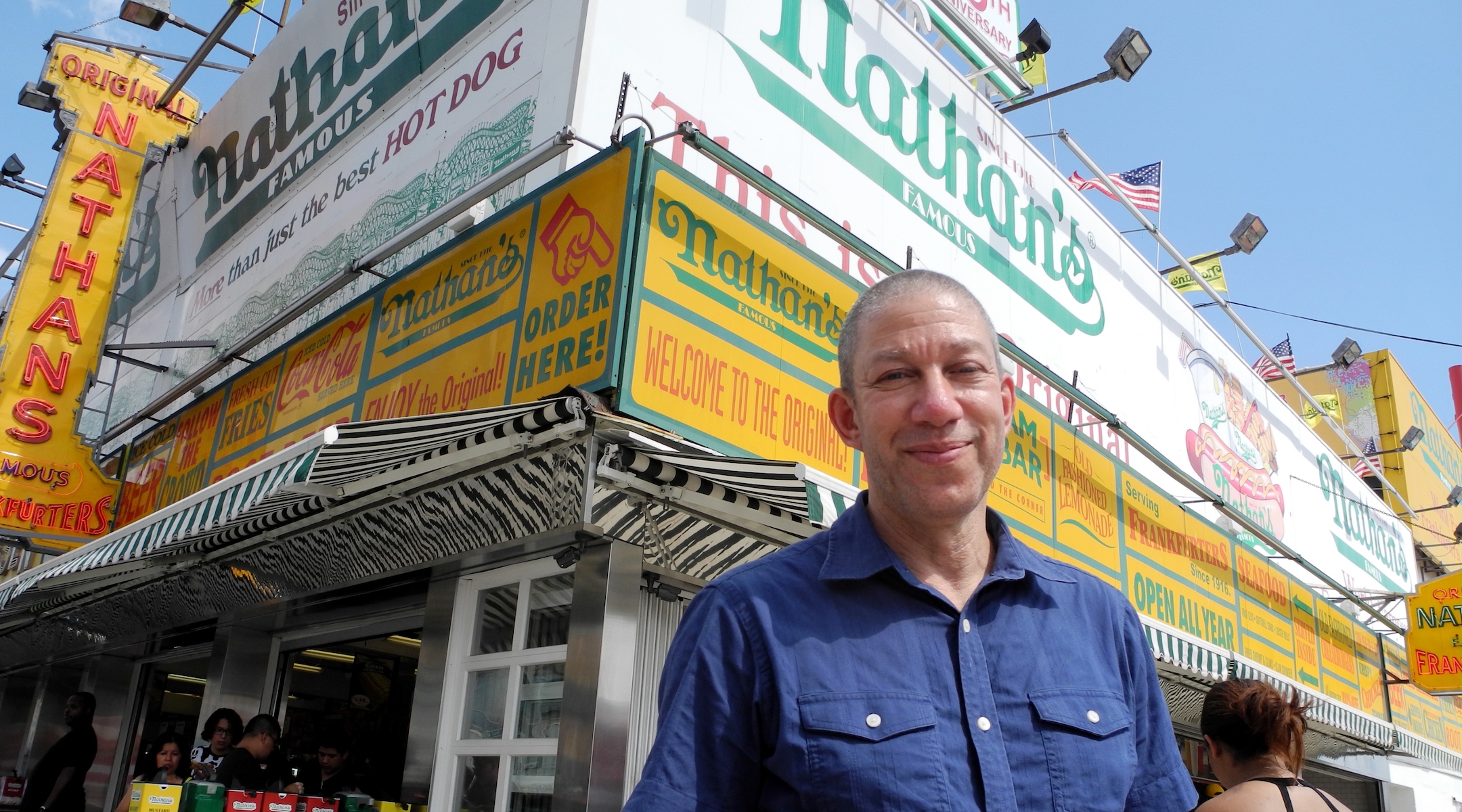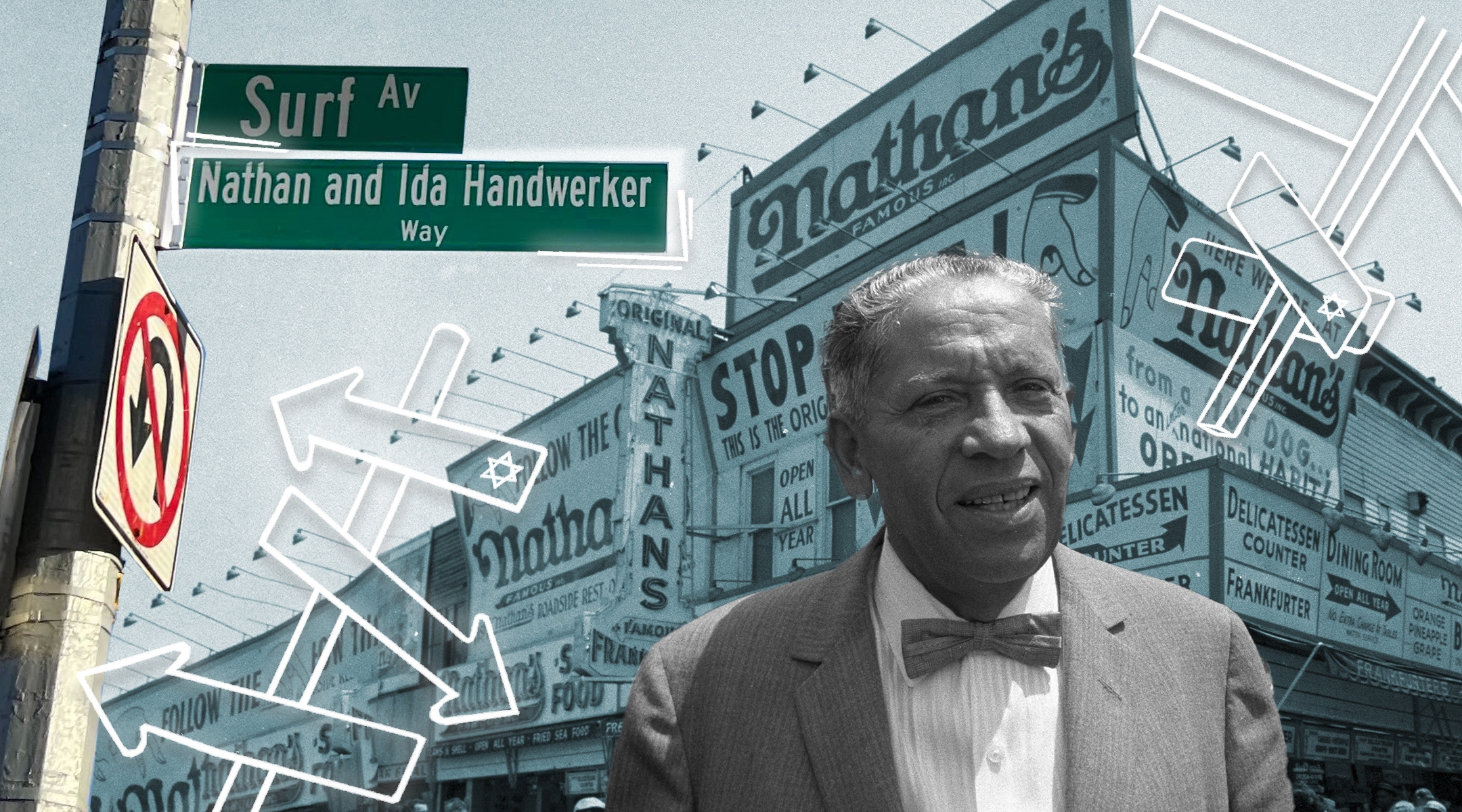(New York Jewish Week) — For many generations of New Yorkers, eating a Nathan’s Famous hot dog from their Coney Island flagship location is a staple of summer. The iconic hot dog stand just celebrated its 107th season at the city’s iconic beachside destination.
Nathan’s Famous — which started as a nickel hot dog stand and grew to a franchised business that today has over 350 locations in 12 countries — may be most famous today for its annual Fourth of July hot dog eating contest. It is named for its founder, Nathan Handwerker, a Polish Jewish immigrant who, along with his wife, Ida, opened Nathan’s Famous in 1916, when he was 19.
“It was his life,” Handwerker’s grandson, Lloyd Handwerker, who made a 2014 documentary and wrote an accompanying book about his family history, both titled “Famous Nathan,” told the New York Jewish Week
“He had brilliant instincts about running a business — basic ideas which seem simple, but they work well,” Lloyd said. “Which is keeping the price low, having the quality be great, being a stickler, paying people well and caring about the customer.”
On Sept. 24, 2016, the 100th anniversary of the founding of Nathan’s Famous, New York City co-named the corner of the Surf and Stillwell Avenues Nathan and Ida Handwerker Way.
“Nathan and Ida Handwerker worked together for over 50 years and were part of the few generations who formed the rich Coney Island culture that is now renowned throughout the nation and all over the world,” Lloyd Handwerker’s cousin, William, said at the unveiling event. “It is an honor to celebrate their legacy by memorializing their names on the street corner that houses the original Nathan’s.”
(Lloyd was supposed to give a speech alongside his family, but his father, Sol, died just days before the ceremony.)
Also present that day was Eric Adams, who at the time was Brooklyn Borough President, and Mark Treyger, the Jewish city council member for District 47, which includes Coney Island. “The corner of Surf and Stillwell Avenues in Coney Island is now known as Nathan and Ida Handwerker Way, after the husband and wife team who grew a hot dog food cart into a brand that is known worldwide,” Treyger said at the ceremony.
“The inspiring story of these two immigrants, who came to this country facing an uncertain future, working hard to create a product that means so much to so many, is what the American Dream is all about,” he added.
Handwerker arrived in the United States from Poland in 1912 and took a job as a delivery boy during the week. On the weekends, he sliced rolls at Feltman’s German Gardens, a restaurant in Coney Island — where he met a waitress who would become his wife.
By 1916, the couple had saved $300, enough to open their own, competing hot dog restaurant. They used Ida’s secret spice recipe to make their hot dogs, for which they charged 5 cents — half the price of a dog at Feltman’s.
Considering the low price of the product, customers were skeptical at first, so Handwerker allegedly hired men to wear white coats while eating his hot dogs. The image would lend his business credibility, as customers figured that if doctors were eating the hot dogs, they could, too.
The business grew steadily over the next half century, with Handwerker working 18-20 hours a day cooking food, selling it and running the business. When the company went public in 1968, Handwerker was elected chairman of the board.
“As a grandfather, he was a very sweet, soft guy. I had no idea what kind of boss he was,” said Lloyd. “It’s different for different people, but I found out he was pretty tough. He was a stickler, and he was clearly a perfectionist about everything — about the quality, about the workers.”
As for Ida Handwerker, in addition to creating the recipe for the hot dogs, she was often in the back kitchen, peeling and chopping onions, garlic and potatoes, Lloyd said. “My grandmother, too, my dad said, was also pretty tough in her own way,” he said. “She worked in the business for many, many years alongside [Nathan], especially in the early days. She was a great grandmother, warm and wonderful. But I guess they both came up hard and tough.”
By the time Nathan Handwerker died in 1974 at 81, Nathan’s Famous Hot Dogs was a household name. Over the years, the hot dog stand became a favorite for celebrities like Barbra Streisand and Regis Philbin. In 1936, the hot dogs were served at a lawn party hosted by President Franklin D. Roosevelt in honor of King George VI and Queen Elizabeth.
The Coney Island location was also an essential stop for politicians from City Council members to the president of the United States. “No one can hope to be elected to public office in New York without having his picture taken eating a hot dog at Nathan’s,” former New York Gov. Nelson A. Rockefeller once told Handwerker during a campaign visit to Coney Island, according to the New York Times.
Handwerker retired to Florida in 1972, with his son Murray taking over and expanding the business. Nathan’s first hot dog eating contest was that same year.

Lloyd Handwerker, grandson of Nathan Handwerker, founder of ‘Nathan’s’, standing in front of ‘Nathan’s’ restaurant in Coney Island, New York, NY, June 29, 2016. (Johannes Schmitt-Tegge/picture alliance via Getty Images)
Lloyd Handwerker, who was 17 when his grandfather died, began working on his film in the 1980s, and over the course of 30 years he interviewed some 75 friends, family members and associates of Nathan’s Famous. “My grandfather was always telling stories around the dining room table at the holidays and dinners,” he said. “By the time I took a video class and had access to a camera, my grandfather and my grandmother had passed away, but I still thought ‘we should be preserving this history.’”
Though he never worked at Nathan’s Famous, Lloyd, who grew up in a Reform Jewish household in Long Island, said that he has fond memories of visiting his grandparents’ office in Coney Island, as well as celebrating Jewish holidays at their house in Florida. “My grandmother cooked amazingly, so I have a lot of great memories of Passover in particular,” he recalled. Lloyd said that though his grandfather grew up traditionally religious in Poland, he didn’t keep many traditional customs by the time he came to the United States.
And yet, some tenets of Judaism were deeply ingrained in the entrepreneur: Though he didn’t hire a rabbi to certify the kitchen, Handwerker coined the term “kosher-style” for his restaurant, because his hot dogs were made with 100% beef and therefore could be kosher.
Plus, “the one day that the restaurant was closed out of the whole year was Yom Kippur, so it still obviously meant something to him,” Lloyd said of his grandfather.
Nathan’s Famous is now owned by Smithfield, a subsidiary of the Chinese meat and food processing company WH Group. However, the family still owns the original Coney Island building and is the landlord for Nathan’s Famous there.
“As far as his legacy, he was obviously very proud of what he created,” Lloyd said of Nathan. “He was a pretty humble guy, but look at what he did: He came from starvation in Poland, without an education. He didn’t know how to read or write, he was basically illiterate and he built this institution that everyone has a story about. It’s amazing.”
The New York Jewish Week brings you the stories behind the headlines, keeping you connected to Jewish life in New York. Help sustain the reporting you trust by donating today.





